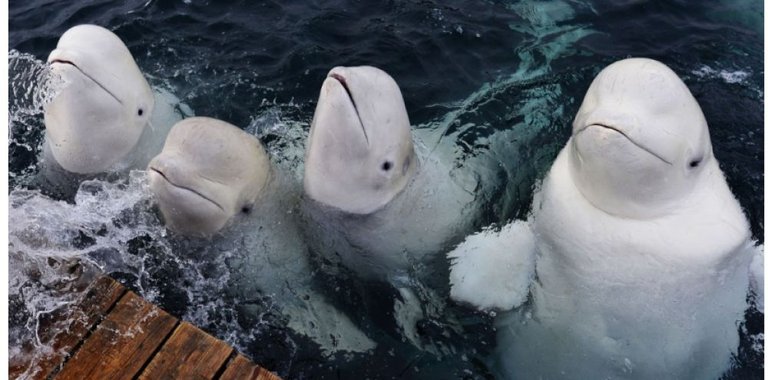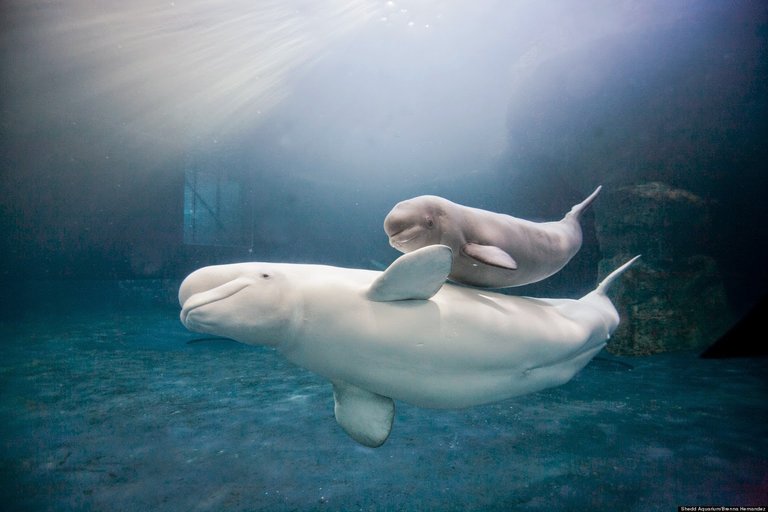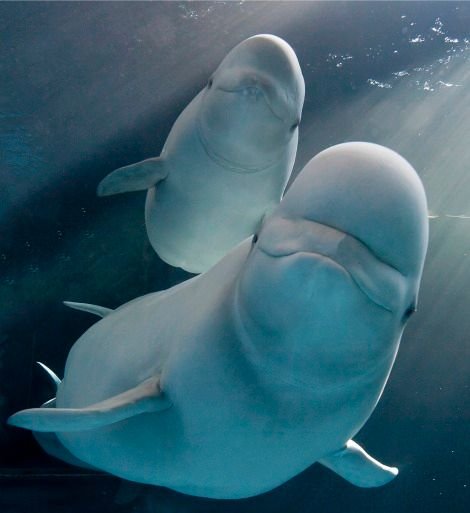The beluga
When I was a child, I wanted to be a veterinarian and especially to look after dolphins and possibly work in a dolphinarium but that was before I boycotted them and I understand that they were not happy in captivity and that they were also tortured to perform their number correctly in public.
It is surely thanks to one of my favorite movies Save Willy and the Flipper series that came to me this love for marine mammals.
Finally, I'm a secretary and I work in an office, nothing to do, you say. Indeed, the only common point is that sometimes I feel like working with animals that are some of my colleagues ...

One of my favorite marine mammals after the dolphin and killer whale is the beluga whale. The word beluga comes from Russian and that means blanchette.
Beluga, also known as the white whale or white dolphin, is a cetacean species that lives in the Arctic Ocean. His sonar is the most sophisticated of all cetaceans. It is essential for him to orient himself and to find his way in the submerged ice channels, which form a real labyrinth.
The male beluga can measure up to 5.50 m, and weigh up to 2 tons. The adult male is usually 25% taller and heavier than the female. The female measures her up to 4m and weighs about 1 ton.
At birth, the small belugas measure about 1.50 m long and weigh 80 kg.
The beluga is different from other cetaceans, because it has a dorsal crest resulting from the atrophy of the dorsal fin and is entirely white, unlike young belugas that are brown and then gray. He has a very short beak and a wide mouth.
The Beluga whale lacks a dorsal fin, which is a natural adaptation that would allow them to break the ice to breathe on the surface and reduce the skin area to reduce heat dissipation.
Sexual maturity occurs at ages 6-9 for males and 4-7 years for females.
Mothers give birth to a single pup in the spring following the 15-month gestation period. The small belugas are dark gray and this color clears with age.
They become white at the age of nine for males and seven for females. The young remain under the protection of the mother for two years.
A beluga lives on average thirty years but can live to a little over 50 years.
Behavior

The beluga is very sociable. It moves in groups subdivided into sub-entities usually composed of animals of the same age and the same sex. Mothers and their young usually integrate small groups.
When sub-entities meet in estuaries, there are thousands of individuals; This represents a significant proportion of the world's beluga population and makes them all the more vulnerable to hunting.
This marine mammal swims relatively slowly and feeds mostly on fish but can also eat octopus, squid or shellfish.
It can go down to 300 meters to hunt its prey and it can go down to a depth of 600 meters maximum.
He can dive for 5 minutes when he hunts and can hold his breath for up to 20 minutes.
It is able to emit a wide range of sounds like whistles or clicks.
That's why we call him the sea canary.
Scientists have isolated about fifty sounds. Some belugas would be able to make sounds that resemble the human voice.
[(Video source)] (www.youtube.com)
Their main predators, apart from humans, are polar bears and orcas. When beluga are trapped by ice, the bears beat them with a paw and haul them over the ice to complete and eat them.
Habitat

The beluga lives in Arctic and subarctic waters. There is also an isolated population for 7000 years that lives in the estuary of the St. Lawrence River and in the Saguenay Fjord around the village of Tadoussac in Quebec.
In the spring, beluga groups reach their summer range: bays, estuaries and other shallow waters. Beluga females return each year to the same summer territory.
When these areas are caught in ice in winter, the groups then move offshore. Most then progress as the pack ice progresses.
Others remain under the ice, surviving thanks to the unfrozen ice packs that allow them to breathe or through the pockets of air trapped under the ice.
The ease with which belugas are able to find areas where the ice is so thin that it is possible to break it to breathe on the surface, while more than 95% of the ice is too thick for it, is a mystery that greatly intrigues scientists. It seems almost certain that this faculty uses the echolocation system to identify areas of lesser density of ice.
Belugas live in bands near shorelines and on the high seas: in Arctic and subarctic polar seas. During the summer they go in shallow, salty and relatively warm waters or with sandy or muddy bottoms. In winter they prefer moving ice zones where open water gives them access to the air.
Dangers
The overall beluga population has stabilized at around 100,000 individuals. There were many more decades ago before the beluga hunt began.
There are approximately 40,000 individuals in the Beaufort Sea, 25,000 in Hudson Bay, 18,000 in the Behring Sea and 28,000 in Canadian Arctic waters. The population of the St. Lawrence estuary is estimated at about 900 individuals.
This cetacean has been observed only a few times in its natural environment. Each of his appearances is therefore exceptional for those who have the chance to see them.
The population of the St. Lawrence estuary is threatened by pollution (organochlorine compounds, polycyclic aromatic hydrocarbons, heavy metals).
Analyzes show a high rate of cancer, the highest of all cetaceans and comparable to that of humans.
Various infections have also been observed, including parasites in the respiratory and gastrointestinal tracts. These infections could be directly related to a contamination by the pollutants present in these waters, which present a potential immoneupressor.
In addition to pollution, other human activities are also a threat to the species. Since the end of commercial whaling, beluga whale watching has become a flourishing activity, particularly in the St. Lawrence River and in the Churchill River (Hudson Bay).
There is an increase in shipping traffic, particularly on the St. Lawrence River, but also an increase in the size of vessels. Noise from boat engines could cause permanent damage to beluga ears.
Studies are underway to determine the impact of these sounds on beluga physiology and behavior. Collisions with boats are also a threat to all cetaceans.
Pollution, shipping and the use of icebreakers are factors that disrupt the beluga environment.
Because of their predictable patterns of migration and group formation, belugas have been hunted for centuries by Arctic natives. The latter used meat for food, fat for fuel, and skin for clothes.
In the mid-18th century, non-natives will be conducting commercial beluga whaling in Hudson Bay, east of Ungava Bay and in the St. Lawrence. Until 1860, oil is in great demand for lighting headlights, streetlights and lamps. Then; he has been hunted for his leather, which is used for the manufacture of horse teams, belts and laces.
Belugas of the St. Lawrence are the most affected by the hunt, in fact, in the 1920s, fishermen observe a decrease in cod and salmon stocks and blame the beluga. Shortly thereafter, the Quebec government offers a premium for each animal slaughtered. In 1946, a study showed that beluga whales were not responsible for fishing problems and they finally ended the hunt for premiums.
Subsistence hunting of beluga whales is still allowed today in some areas and by some populations, within reasonable limits. However, in other areas such as Anchorage Bay, Ungava Bay and off the west coast of Greenland, commercial hunting, now banned, has put population survival at risk living there.
Although unauthorized, aboriginal beluga hunting continues in these areas and it is regrettable that beluga populations in these areas will be extinguished.
There is a dialogue between Inuit and governments to create an intelligent and reasonable hunt. This hunt also added the beluga to the list of endangered species in 1994.
Captivity
I did not know that beluga whales could end up in dolphinaria like dolphins but unfortunately yes.
With the dolphin and the killer whale, the beluga is one of the few species of cetaceans found in the West's aquariums. Their popularity is largely due to their characteristic color and facial expressions. While most dolphins have a fixed smile, the beluga's cervical flexibility allows for a broader repertoire of facial expressions.
Most of the belugas held in aquariums have been captured in the wild as the animal's adaptation programs to captivity have met with some success and therefore it is easier to capture in the state. wild than to breed in captivity.
I hope this article has allowed you to know a little better this beautiful animal.
Have a good day friends !
I love the sound it makes :) it's pretty, then it has a comic head :D Thank you for all these details !
They are so smart and so friendly...
l love Flipper too. The first time l saw the dolphins there. but l have never seen beluga before. thank you for amazing information about the beluga. @lndesta120282
Nice to see people are sharing their love to animals and nature. Keep loving nature. You will be happy man @Indesta120282
It's good . Keep posting like this. And please also follow @cryptocharmer
Lumba-lumba yang sangat langka, aku menyukai nya karena ditempat kami susah menemukan nya
You are the Best!!
@Indesta120282, I really enjoyed reading that post, it was very informative and I am especially suprised by the behaviour of the Beluga Whale.
It is ver sad indeed that such special animals are kept in captivity, many of us are aware of the intelligence of these mammals, the social aspect is really intriguing. I wonder what there conciousness is like, I am very curious.
Thank you :)
Really nice sharing your stories with us.
I love watching dolphins, its fun to watch the game, working with it is really a lot of fun, many beautiful posts, I like it,

thanks for sharing
that's a great story. just mind blowing. Realy I'm fall in love with this story. Dear I'm just waiting for your next pretty Story.
Lots of thanks for sharing nice Story.